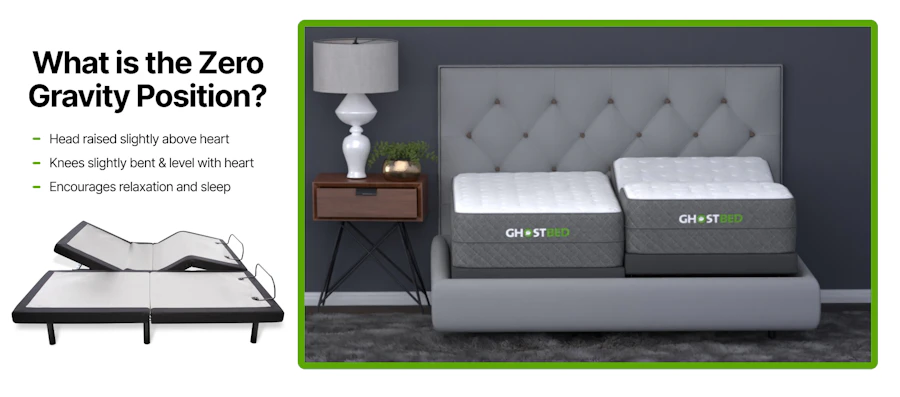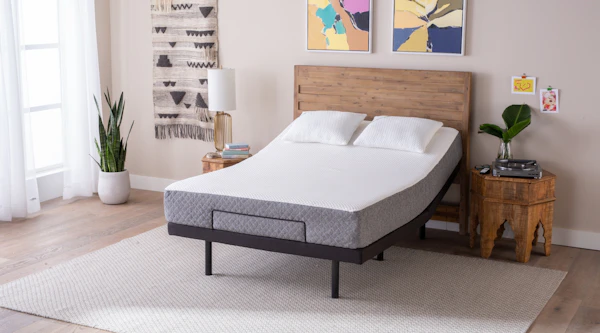6 Benefits of a Zero Gravity Adjustable Bed Base
Last Updated on November 16, 2025
by Marc Werner, Founder - GhostBed
Are you searching for a simple way to achieve deeper, more restorative sleep? Many sleep experts will suggest trying a zero-gravity sleeping position if getting the ZZZs you need is a challenge.
To some, this idea may sound like something out of a futuristic science fiction film. But the truth is, zero-G sleeping is completely attainable… when you have the right adjustable frame for your mattress. Watch the short video below to learn all about how the zero gravity sleep position can benefit your well-being. Or, keep reading and we'll also tell you how to select the perfect adjustable base/mattress combo to get you started.
What is Zero Gravity?
First, let’s explore what zero gravity is. Of course, we know what gravity is: the invisible force that pulls objects toward each other. It’s what causes water to rest at the bottom of a glass instead of floating away.
The definition of zero gravity or zero-G, in contrast, is the state or condition of weightlessness. Think of the last time you visited an amusement park to take a thrilling ride on a rollercoaster. That moment when you hit a loop and feel weightless is what zero gravity feels like. This is because there isn’t a supporting force acting upon your body, keeping you down.
Typically, astronauts floating around in space are the only ones who get to experience zero-G, but that’s all changing. The mattress industry has perfected the adjustable base since it was first introduced 113 years ago in 1909, making a zero gravity sleep position possible for everyone!
What is the Zero Gravity Sleep Position on an Adjustable Bed?

The zero gravity position is a method of elevating your head, knees and legs slightly above your heart to create a feeling of weightlessness. It can help your body relax and drift off to sleep faster.
Just as we can thank NASA for the luxurious comfort of memory foam mattresses, we can also thank the space agency for developing the zero gravity position. NASA uses the term to describe the positioning for astronauts to balance their weight as they launch into space, Because astronauts withstand extreme and sudden increases in gravity while exiting the Earth's gravitational pull, it's essential to assume a position that decreases this stress on their bodies.
When we refer to the zero gravity position down here on Earth, we're usually talking about replicating that feeling of weightlessness with the help of an adjustable bed frame placed underneath your mattress. There are also many zero-G lounge chairs on the market due to this position's comfort and benefits.
When you set your bed frame to the zero gravity position, your legs and head are raised at just the right angle to distribute your weight evenly. The angle of the thighs and torso are aligned as the upper body and head are raised a bit, and the knees slightly bend as the legs are raised to about heart level. This position can increase your circulation, relieve back pain and encourage healthy (and relaxed) sleep.
Benefits of Sleeping in the Zero Gravity Position

Pain relief is where zero-gravity sleeping truly shines. Pressure points are relieved in the zero-G position, blood flow is improved, and swelling is reduced – among many other health benefits. But that’s not all that a zero-G adjustable bed frame can do for you! Let’s explore the top 6 benefits of sleeping in a zero gravity bed together.
1. Less Back and Neck Pain
Did you know that the human body has an S-shaped spinal column? With that in mind, it's easy to understand why laying completely flat on a bed each night can add unnecessary pressure on your body as your weight isn't distributed evenly. And as comforting and luxurious as a memory foam mattress can be when conforming to the body, laying flat on any bed can cause (or even exacerbate) neck and back pain by affecting spinal alignment and more.
Since zero gravity evenly distributes your weight, this can relieve a lot of the pressure in your spinal column, neck and back. The result? More leisurely mornings marked by feelings of enthusiasm, joy and refreshment instead of aches, pains and grogginess.
2. Reduced Snoring
With your head slightly elevated in the zero gravity position, your airways are able to function more efficiently as they remain open. This prevents your tongue from slipping back during sleep, which is one factor that is known to cause snoring. You’ll find yourself getting deeper, better sleep when your snoring is finally under control. And we think your sleeping partner will appreciate the quieter rest too (human or otherwise).
3. Improved Heart Health
As we previously mentioned in our article on which side to sleep on for optimum health, we addressed how your sleeping position can affect your heart. The zero gravity position takes extra pressure off your heart, allowing for better blood flow and circulation.
4. Decreased Heartburn and Acid Reflux
If you’re battling acid reflux at night, the zero gravity position may be the solution you’ve been searching for. With your upper body elevated, stomach acids can’t easily travel back up your throat. Health professionals often recommend that people with Gastroesophageal Reflux Disease (GERD) sleep with their upper body elevated. So, if you’re regularly feeling the burn at bedtime, it may be wise to consider elevating your body into a zero-G position.
5. Reduced Swelling
Swelling, or edema, is extremely uncomfortable and can be caused by many medical conditions such as acute injury, liver disease, cellulitis, diabetes and even menopause and pregnancy. If you’ve ever twisted your ankle and gone to the doctor for treatment, there’s a good chance they suggested you follow the R.I.C.E. method, which stands for rest, ice, compression and finally elevation. A zero-gravity base will allow you to stay on top of the contributing factors to swelling and aid in treating injured ankles, legs, hands, wrists and more by facilitating easy elevation each night.
6. Improved Breathing
Allergies, asthma and other respiratory illnesses can wreak havoc on your sleep. Sleeping with your torso elevated in the zero gravity position will reduce the pressure on your lungs and air passages, allowing for better and more relaxed breathing. You’ll also get relief from nose stuffiness, since elevating your head can open up your nasal passages. So, if you’ve been recovering from an acute infection caused by a bacteria or virus, a zero-gravity position may help provide some much needed relief.
Adjusting Your Bed to Zero Gravity
With GhostBed, setting your adjustable bed frame to the zero gravity position is as easy as the push of a button. On your wireless remote, simply look for the preset button labeled “ZG” to activate the built-in setting for Zero-G. The bed will then effortlessly move into position for you. At GhostBed, we’ve found the perfect zero gravity position to elevate your head by 8 degrees and your feet by 40 degrees.

GhostBed’s Zero Gravity Adjustable Bed
Ready to see how zero-gravity can revolutionize your sleep, wellness and outlook on life? In that case, we suggest considering the GhostBed Adjustable Base which allows for infinite ergonomic positions, including zero gravity. With additional features like 15 whisper-quiet massage modes, under-bed LED lighting and two USB ports, it’s now possible to treat yourself to the ultimate in comfort and luxury for thousands less than other adjustable bases on the market.
Relax and put your feet up (literally) with the luxury GhostBed Adjustable Base. Enjoy independent head and foot adjustability, massage settings & more.
Shop NowMarc has spent the last two decades designing & manufacturing mattresses and other sleep products, drawing on a lifetime of experience working with the material sciences. With several patents to his name, he works closely with the GhostBed team to create products with the perfect balance of comfort & support. Learn More


